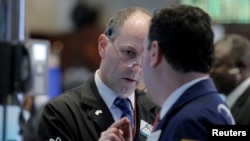The major stock averages traded higher Friday, with consumer discretionary and technology sectors leading the way, to close the week on an up note on very thin volume.
The Nasdaq was the big winner as Apple traded back to $100 a share to help the index lock in a 3 percent weekly gain.
The U.S. dollar moved higher in anticipation of the June interest rate hike, while gold saw its fourth weekly drop. The dollar and gold typically have an inverse relationship.
Trading week ahead
U.S. markets will be closed Monday in observance of Memorial Day. London markets will also be closed Monday in observance of the Late May Bank Holiday.
Crude oil hit a seven-month high, testing the $50-per-barrel mark ahead of the Organization of the Petroleum Exporting Countries meeting on June 2. Supply outages in Canada and Nigeria and economic instability in OPEC member Venezuela led to a drawdown in crude, which helped the price recovery. But if prices stabilize in the $50-$60 range, could the balance be disrupted once again?
“As the U.S. dollar moves higher on interest rate hike speculation — and it most certainly will if it comes to fruition — commodities like crude oil will be impacted as oil and other commodity prices move lower,” Ernie Goss, professor of economics at Creighton University, said. “But, more importantly, as crude oil prices have temporarily moved higher recently, shale producers will ramp up production again, and that will only add back to the supply glut, further reducing prices.”
The spotlight during the OPEC meeting will be on unity between Saudi Arabia and Iran as interaction between the two exporting nations has declined. Saudi Arabia is operating under a new oil minister, and Iran is pumping close to pre-sanctions levels. The Saudis maintain their aggressive stance in OPEC and are keeping producers on the hook as they look to gain additional traction for the proposed listing of Aramco, the state-owned oil company.
Global data dependency
Market participants now believe there is a 30 percent chance that the Federal Reserve will raise interest rates by 0.25 percent at the Federal Open Market Committee meeting on June 14-15. And while some believe that the Fed has to raise rates in order to save face as members have become more hawkish in recent weeks, the committee still remains data-dependent, and some of the most important monthly data points will be released next week.
Some investors believe, however, that the Fed may potentially wait until later in the summer. “July seems more likely, if not later, like late summer. The last thing the Fed wants to do is jump the gun, yet it must be wary of the slow but steady creeping up in the inflation numbers,” Skip Raschke, founder of SOTDaily.com, said. “Thus, watching the cost of gasoline, as well as the food commodities [corn, wheat, coffee, etc.], makes sense in order to try to guess when the Fed makes its move. My best guess is that will be in late summer.”
Fed Chairman Janet Yellen said late Friday in remarks at a Boston speaking engagement, “Probably in the next couple of months, another increase is ‘appropriate.’ ”
Perhaps the most important piece of economic data the Fed will review prior to the rate decision is the Non-Farm Payrolls report, which is released on the first Friday of every month. The employment data give the most comprehensive report of how many people are looking for jobs, how many have them, what they're getting paid and how many hours they are working. These numbers are the best way to gauge the current state, as well as the future direction, of the economy.
Other key data include Personal Income and Outlays, and ISM Manufacturing and Motor Vehicle Sales. Recall that Retail Sales were exceptionally strong for April. Income and Outlays will be closely watched because it is another indicator of the strength of the consumer, since income is the major determinant of spending. As income increases, spending will, too, and that is interpreted as a positive for the economy, since consumer spending accounts in the U.S. for nearly 70 percent of gross domestic product.
Earnings reports
Just three S&P 500 companies are scheduled to report earnings: Medtronic, Michael Kors and Broadcom. According to data from S&P Global Market Intelligence, the earnings beat rate in the first quarter is currently 68 percent, ahead of the historic average of 66 percent.






